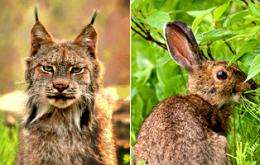Researchers Find Key 'Conductor' of Nature's Synchronicity

(PhysOrg.com) -- Synchronicity in nature is seen in beating hearts, the flashing of fireflies' lights, the ebb and flow of infectious disease—and the simultaneous rise and fall of populations across vast reaches of space. While scientists have identified some factors that account for this melodic phenomenon, they have yet to sort out the relative contribution each plays in this finely tuned orchestra.
Now researchers at Yale University and the University of Calgary report in the July 22 issue of Nature's advanced online publication that predator-prey interactions are the "conductors" of synchronicity in living organisms.
"Change these interactions and you can suffer disastrous consequences to these systems," said David Vasseur, co-author of the paper and assistant professor of ecology and evolutionary biology at Yale.
Vasseur and Jeremy Fox, professor of biological sciences at Calgary, set out to find a way to tease out which factors are most important in creating spatial synchronicity. The close relationship in the rise and fall of populations, for instance, has been well documented in Canadian lynx and snowshoe hare populations. Changes in the abundance of lynx and hare measured at one location are closely mimicked over the entire continent.
Researchers have identified three main causes of synchronicity - the simultaneous rise and fall of populations in different locations. For example, individual snowshoe hares or lynx living in isolated populations can move into other isolated populations. This factor—called dispersal—can link the rise and fall of populations.
The second factor is called the Moran effect, which stipulates that isolated groups of animals experiencing similar environmental fluctuations—such as droughts—will tend to rise and fall in unison.
The third factor is interactions of species—such as the predator-prey relationship.
To test which of these factors is most important, Vasseur and Fox devised a model coupled to a series of experiments that tracked numbers of freshwater microorganisms stored in bottles. They swapped organisms between bottles (dispersal), grew bottles in identical temperatures (the Moran effect), and introduced a predator that eats the microorganism. They tested all combinations of these factors. For instance, they dispersed organisms among bottles with identical temperatures in one treatment and kept organisms in identical temperatures with no dispersal in another. They found a consistent synchronicity in populations in response to temperature change. However, swapping organisms created synchronicity only when predators were present. Without the predators, populations didn't synchronize when individual organisms were exchanged.
"Predators fundamentally change the way that their prey vary through time, creating a cyclic pattern that is quickly synchronized across many locations with only small amounts of dispersal," Vasseur said. "The loss of these cycles, either through species extinctions or global change, may have drastic consequences for the stability of ecosystems and the persistence of species."
The presence of predator creates a cyclic pattern nearly identical to that found in other examples of synchrony in nature.
"This synchrony is achieved in the same manner as many other naturally synchronizing phenomena," Fox said. "Cyclic systems, from flashing fireflies to lynx and hares, are like kids bouncing up and down on a trampoline. Adding predators is like making them hold hands, so they all have to bounce together."
Source: Yale University (news : web)

















